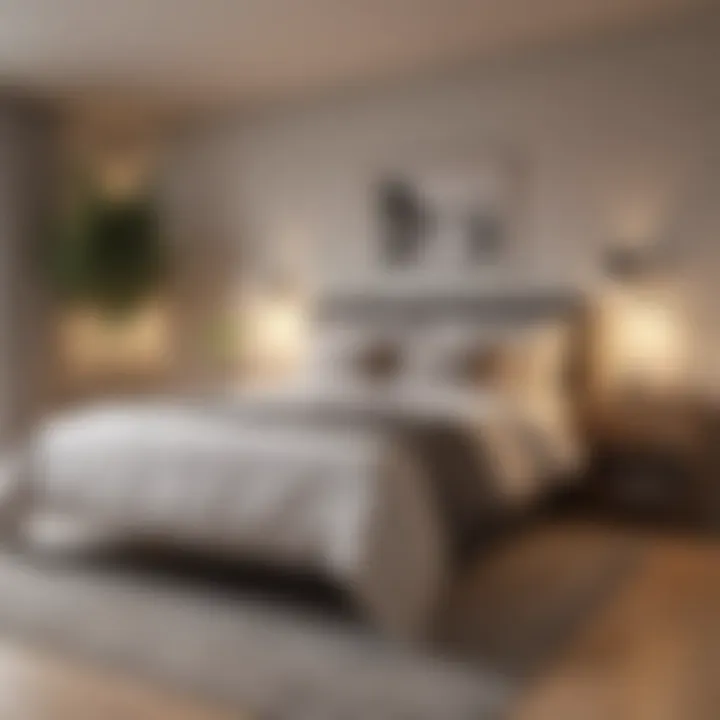Ultimate Guide to Cleaning Your New Home Before Moving In


Intro
This guide aims to equip you with comprehensive insights on how to thoroughly clean your new home. We will discuss the pivotal areas to prioritize, the best methods to use, and the significance of each cleaning step. By maintaining a high standard of cleanliness, you ensure a welcoming atmosphere aligned with modern living. Let’s explore the crucial aspects of preparing your new dwelling.
Understanding the Importance of Cleaning
Health Considerations
Cleaning plays a crucial role in ensuring a healthy living space. Residues from previous occupants, dust, and allergens may linger in a new home without careful cleaning. These can lead to various health complications, including respiratory issues, allergies, or infections.
In sections like kitchens and bathrooms, the risks increase dramatically if not addressed properly. Mold and bacteria thrive in damp or unclean areas, possibly leading to severe health issues. For instance, routinely cleaning surfaces with effective disinfectants not only removes dirt but also sanitizes areas that are prone to harboring harmful microorganisms.
Moreover, with people spending considerable time indoors, maintaining air quality is vital. Dust and allergens can easily accumulate, causing discomfort and even triggering asthma. Therefore, the act of cleaning must prioritize removing dust from vents, surfaces, and floors.
Psychological Benefits
The significance of cleaning extends beyond the physical realm. A clean environment fosters mental well-being. When moving into a new space, feelings of anxiety or apprehension can be prevalent. A meticulously cleaned house enhances the sense of order and tranquility. This can provide comfort and peace of mind, allowing occupants to settle quickly.
Furthermore, a clean space syncs with productivity and positive energy. Research has shown that cluttered environments can lead to stress and distraction. Therefore, the act of cleaning not only freshens the space physically but also mentally revitalizes those inside it.
"An organized and clean environment can enhance focus and tranquility, making it essential for optimal living experiences."
The psychological benefits of cleaning should not be underestimated. It helps create a place that individuals feel proud to inhabit. This calming influence ensures that one can enjoy their new home fully, rather than being bogged down by remnants of the past.
Preparing for the Cleaning Process
Preparing for the cleaning process is a critical step that sets the tone for the overall efficiency and effectiveness of your efforts. This phase involves a detailed understanding of what it takes to transform a new house into a clean and inviting space before moving in. Being organized is fundamental. A robust preparation routine not only saves time but also ensures that you address all areas requiring attention, thus promoting a cleaner environment.
When you prepare adequately, you can avoid distractions during the actual cleaning. This results in a smoother workflow, preventing the common pitfalls of repeated tasks or overlooked items. Furthermore, effective preparation contributes to reducing potential stress associated with moving into a new home. Overall, it leads to a more successful cleaning operation and enhances your initial experience in the new space.
Gathering Necessary Supplies
Cleaning agents
Cleaning agents are essential to achieving a thorough and hygienic clean. These products vary in formulation and effectiveness, and their role in the process cannot be overstated. A key characteristic of quality cleaning agents is their ability to break down dirt and grime efficiently. Eco-friendly cleaning agents are popular choices for many homeowners due to their lesser impact on the environment. These products often contain natural ingredients that are effective against bacteria and stains, making them a safe option for households with children or pets.
One unique feature of many modern cleaning agents is their multi-purpose formulation. This means that a single product can tackle various surfaces and stains, reducing clutter in your cleaning supply inventory. However, it’s important to be cautious with the concentration of certain cleaning solutions, as some may irritate the skin or damage surfaces if not used correctly.
Tools and equipment
The tools and equipment you choose for the cleaning process directly impact the ease and efficiency of your efforts. High-quality tools, such as microfiber cloths, mops, and vacuum cleaners, can enhance cleaning performance in various spaces. A key characteristic of good cleaning tools is their durability and effectiveness, which contribute significantly to overall cleanliness.
One popular choice among homeowners is the vacuum cleaner. These devices come with various attachments and features, such as HEPA filters that trap allergens, making them an excellent choice for those concerned with air quality. However, one must consider the maintenance required for such equipment, as well as the need for replacement parts over time.
Protective gear
Protective gear is often overlooked but is crucial during the cleaning process, especially when working with harsh chemicals. The most significant aspect of protective gear is the safety it provides. Gloves, masks, and goggles offer vital protection against potential irritants and harmful substances present in cleaning agents.
A beneficial quality of good protective gear is its comfort and fit. Ensuring that these items are easy to wear can encourage proper use throughout the cleaning process. A unique feature of some modern protective gear is the use of breathable materials, which allow for comfort during extended periods of use. However, it's essential to ensure that the gear meets safety standards, as subpar products can be ineffective.
Establishing a Timeline
Having a clear timeline for cleaning is essential for staying organized and focused. Determine how much time you can dedicate to the cleaning process and create an outline for your tasks. Assign specific days or chunks of time to particular areas. This not only makes the project feel less overwhelming but also provides tangible goals to work towards. A well-defined timeline facilitates progress tracking and helps you gauge how much work remains.


Developing a Cleaning Checklist
Creating a cleaning checklist is a practical step that aids in staying organized. This list should be specific to each room and highlight what needs to be addressed. Break tasks down into manageable actions, such as cleaning baseboards, wiping down surfaces, or sanitizing kitchen appliances. Having a checklist not only ensures that no area is neglected, but also offers a satisfying way to mark off completed tasks as you move through the home. With this level of organization in place, you are now ready to tackle the comprehensive cleaning required for your new home.
Room-by-Room Cleaning Strategy
Cleaning a house room by room is a systematic approach that simplifies the entire process. It enables one to focus on each area individually, ensuring no space is overlooked. This strategy breaks down the chore into manageable parts, making it less daunting and more efficient. By tackling specific rooms, you create a comprehensive cleaning routine that can be repeated with ease in the future.
Effective room-by-room cleaning also minimizes cross-contamination. Moving from one area to the next ensures that dirt and allergens do not spread from one zone to another. This method prioritizes thoroughness and cleanliness, ensuring that the new home is not only aesthetically pleasing but also hygienic for the inhabitants.
Entryway and Hallways
The entryway and hallways set the tone for your home. These transitional spaces often accumulate dust and dirt, becoming a catchment for outdoor debris. Using a simple vacuum or broom will help clean floors effectively. Wiping down surfaces like walls and light switches with disinfectant can provide a fresh start.
Living Room
Upholstery cleaning
Upholstery cleaning is critical for maintaining a fresh living space. It removes allergens like dust mites and pet dander that can accumulate in furniture. Cleaning upholstery restores its appearance and contributes to a healthier indoor environment. It is a recommended practice for anyone concerned about indoor air quality. The downside is that some materials may require special cleaners or professional service.
Floor maintenance
Proper floor maintenance goes beyond just sweeping. Different flooring materials require specific care techniques. Regular vacuuming or mopping helps keep surfaces in good condition while removing dirt and debris. This method prolongs the life of your flooring. However, one must be cautious to use the right cleaning solutions to avoid damage.
Window treatment
Window treatment serves not just a decorative purpose but also enhances cleanliness and comfort. Cleaning windows allows more natural light into the space, contributing to a brighter atmosphere. Streak-free cleaners are often a preferred choice as they provide a clear finish. However, accessing high windows can pose a challenge.
Kitchen
Appliance sanitization
Sanitizing kitchen appliances is essential to eliminate germs and bacteria. It involves deep cleaning items like refrigerators and ovens, often using specific cleaners that can reach tight spaces. Regular sanitizing prevents the buildup of harmful organisms, making it a crucial aspect. One limitation is that certain appliances may have parts that are delicate and require careful handling.
Cabinet cleaning
Cabinet cleaning ensures the storage areas are free from old food particles and grime. This task extends the life of cabinetry and keeps your kitchen looking sharp. Many people overlook this task, but it is vital for overall cleanliness. The downside is that cleaning inside cabinets can be time-consuming.
Countertop disinfection
Disinfecting countertops is a must to maintain a healthy kitchen. Preventing cross-contamination during food preparation protects against foodborne illnesses. Many prefer using anti-bacterial wipes or sprays for quick disinfection. However, not all surfaces respond well to every cleaning product, which can complicate the cleaning process.
Bathrooms
Toilet sanitization
Toilet sanitization is non-negotiable for a healthy home. Regularly disinfecting toilets can eliminate harmful bacteria and prevent odors. This straightforward task typically requires a strong cleaner. Unfortunately, some products may have strong chemicals, which could be undesirable for some homeowners.
Shower and tub cleaning
Shower and tub areas often gather soap scum and mildew. Effective cleaning here not only improves appearance but also enhances safety by reducing slipping hazards. Many opt for specialized cleaners designed for bath surfaces. However, persistent stains can sometimes resist cleaning efforts.
Surface disinfecting


Disinfecting surfaces in the bathroom is essential for hygiene. Focus on high-touch areas such as faucets and light switches. The process involves applying disinfectants while following recommended dwell times. The challenge may arise from varying material surfaces that require particular products, making it a task that demands attention.
Bedrooms
Mattress cleaning
Cleaning your mattress is vital for reducing allergens and ensuring better sleep quality. Significant dust and dirt can accumulate in mattresses over time, affecting health. Regularly vacuuming and using a mattress protector can help maintain hygiene. The downside is that some stains or odors may not come out easily in a simple cleaning process.
Closet organization
Organizing your closet enhances usability and transforms the space. A well-organized closet allows for easy access to items and creates a more pleasant living environment. This task can also uncover items you might not have used in a while. However, it requires effort and time, which some may find daunting.
Surface dusting
Surface dusting in the bedroom helps reduce allergens and keeps the area looking fresh. Using a microfiber cloth can efficiently pick up dust without spreading it around. This simple task should not be overlooked, as it contributes to overall air quality. However, reaching high places can be tricky without the right tools.
Laundry Room
The laundry room, often forgotten, should not be overlooked in the cleaning process. This space accumulates dust and lint, which can lead to poor air quality. Regular cleaning of surfaces, machines, and floors enhances functionality and ensures safety. It may require unique cleaning methods based on the materials present in the room.
Addressing Special Considerations
Cleaning a new house is not simply a matter of wiping surfaces and vacuuming floors. There are special considerations that must be taken into account to ensure a truly fresh and welcoming environment. Focusing on these elements can significantly enhance your living space's overall health and comfort. Addressing allergens and odors is particularly crucial, as these factors can affect both physical health and mental well-being. When moving into a new home, it’s vital to make it not just clean, but also safe and pleasant to inhabit.
Dealing with Allergens
Air filter replacements
Air filters are an integral part of any home's heating and cooling system. Replacing them before moving in can greatly improve air quality. New filters capture dust, mold spores, and allergens, ensuring you breathe clean air. An important characteristic of air filters is their efficiency rating, indicated by the MERV (Minimum Efficiency Reporting Value) which ranges from 1 to 16. For residential use, a MERV rating of 8 to 13 is considered effective.
Replacing air filters is a simple process that can yield substantial benefits. One unique feature of high-efficiency particulate air (HEPA) filters is their ability to trap 99.97% of particles that are 0.3 microns in size. This offers an advantage for those with allergies or respiratory issues. However, it is worth noting that while HEPA filters excel at filtration, they can be pricier than standard options. Proper maintenance and timely replacements are critical to maintaining their effectiveness, so make sure to mark your calendar for new replacements regularly.
Deep carpet cleaning
Deep carpet cleaning is another essential step to consider. Carpets can harbor allergens such as dust mites, pet dander, and mold. Therefore, cleaning them thoroughly before moving in is important. The key characteristic of deep carpet cleaning is its focus on eliminating dirt and allergens at a deeper level than standard vacuuming.
The most common method for deep cleaning carpets is using hot water extraction, often referred to as steam cleaning. It involves injecting hot water mixed with cleaning solutions into the carpet, then extracting the mixture along with dirt. The significant advantage of steam cleaning is its ability to kill germs and allergens due to the high temperature of the water. However, it requires time for carpets to dry and may not be practical for all types of carpet fibers.
Removing Existing Odors
Removing existing odors is crucial when moving into a new house. Unpleasant smells can emanate from various sources, including previous tenants, pets, or lack of ventilation. An effective approach involves multiple strategies:
- Ventilation: Ensure that windows are opened to let fresh air circulate.
- Natural Deodorizers: Baking soda is a well-known agent for absorbing odors. Sprinkling it on carpets and leaving it overnight can eliminate lingering smells.
- Professional Odor Removal: For persistent odors, it may be necessary to hire a professional cleaning service that specializes in odor removal.
This step is not just about comfort; it also contributes to mental clarity and the overall enjoyment of your new space. Achieving a fresh smell can often mark the transition from the previous occupants’ presence to your own, making the house feel more like a home.
"Creating a welcoming environment begins with addressing the nuances of cleanliness. A little extra effort in special areas goes a long way."
By focusing on allergens and odors through these methods, you can create a pleasant and healthy atmosphere in your new home. Taking these special considerations into account will enhance not only hygiene but also the psychological comfort of your new living space.
Final Touches and Maintenance
Final touches and maintenance play a crucial role in ensuring that the cleaning process is fully effective and that the home remains welcoming and hygienic. After the heavy lifting of deep cleaning rooms in the new house, it is essential to focus on organizing the space effectively. This not only aids in smoother transitions but also sets the tone for life in the new environment. A well-maintained home allows for better functionality and overall satisfaction.


Setting Up for a Smooth Transition
Organizing essentials for easy access
Organizing essentials for easy access means strategically placing frequently used items in a way that facilitates easy reach. This aspect is significant during the initial days in a new home. It helps adjust quickly to the new environment. An orderly setup not only enhances practicality but also reduces stress during the unpacking phase.
One key characteristic of organizing essentials is prioritization. Think about daily needs such as toiletries, kitchen utensils, and cleaning supplies. By identifying these items and having them accessible, you streamline daily routines.
A unique feature of this organization is the ability to tackle chaos immediately after moving in. The advantage is clear: it minimizes the overwhelming feeling often associated with unpacking, offering a sense of control in the new surroundings. In contrast, neglecting this organization can lead to a cluttered and chaotic environment, which can be counterproductive.
Labeling boxes
Labeling boxes brings clarity and systematic order to the moving process. This step is integral for effective unpacking, ensuring that you know where each item belongs. A key characteristic of labeling is its simplicity; it takes just a few moments to mark which room a box belongs to, saving hours of searching later.
This practice is beneficial because it maximizes efficiency. With clear indications of contents, finding essential items becomes straightforward. A unique feature of labeling is that it provides visual cues during the unloading process. Moreover, it can help others who assist in the move to know where to place boxes in the new house.
However, an occasional downside may arise if the labeling is not precise or durable, leading to potential mix-ups later on. Overall, the advantages of this practice far outweigh such inconveniences and are worth considering.
Planning for Future Maintenance
Future maintenance planning is vital for preserving the cleanliness achieved post-move. By establishing a regular cleaning routine, homeowners can ensure that their new space remains inviting and healthy. This task is essential not just for aesthetics but also for prolonging the condition of the home.
One method to plan for maintenance is the creation of a cleaning schedule. This approach allows for predictable upkeep, making it easier to manage tasks across the week or month. Additionally, it instills a sense of responsibility toward the living space.
Using checklists for efficiency can streamline this maintenance process. Incorporating routine checklists ensures no tasks are overlooked. Whether it is a monthly deep cleaning or weekly tidying up, such systems enhance both effectiveness and satisfaction in the long run.
"A systematic approach to cleaning and maintenance can drastically improve the living experience in your new home."
By focusing on final touches and future maintenance, you create an environment that feels both comfortable and welcoming. This proactive stance not only aids in settling down but also encourages a heightened appreciation for the new living space.
Post-Move Considerations
In the process of transitioning into a new home, the phase following the move deserves careful attention. Post-move considerations not only facilitate a smoother adjustment to your new environment but also help uphold the cleanliness standards established prior to moving in. Addressing specific aspects during this stage can significantly influence your comfort and overall satisfaction with the new space.
Settling In
Once you have moved into your new house, settling in is crucial. This phase is about making the space feel like home. Unpacking strategically can enhance organization. Prioritizing the essential areas, such as the kitchen and bedrooms, can aid in creating a functional living space quickly. Arrange items in ways that reflect your daily routines. This intentional setup minimizes disruption and allows for efficient usage of the area.
It is also important to personalize your space. Adding personal touches fosters a sense of belonging. This could include displaying photos, hanging art, or incorporating cherished belongings. Moreover, take the time to assess the storage solutions available. Utilizing closet space effectively or investing in shelving can create a more organized environment.
Regular Cleaning Routines
Establishing a consistent cleaning routine is fundamental for maintaining a pristine living environment after your move. A regular cleaning schedule ensures that your home remains orderly and welcoming. It prevents the buildup of dust and grime, making future cleaning easier.
Creating a cleaning schedule
Creating a cleaning schedule serves as a structured approach to upkeep. It clearly outlines tasks to be completed daily, weekly, or monthly. This methodical organization helps to keep your home clean without becoming overwhelming. One key characteristic of an effective cleaning schedule is its adaptability. Tailoring the routine to fit your lifestyle makes it sustainable in the long run. Additionally, you may find it helpful to assign specific days for particular tasks. For example, dedicating Mondays to bathroom cleaning or Thursdays to dusting surfaces.
The unique feature of creating a schedule lies in its accountability. This method encourages routine adherence. As a result, you develop habits that contribute positively to maintaining cleanliness. However, inconsistency in following through can diminish the effectiveness of this strategy. Therefore, it is essential to stay disciplined and adjust the schedule whenever necessary.
Using checklists for efficiency
Using checklists enhances the efficiency of your cleaning endeavors. A checklist serves as a visual guideline for tasks that need to be accomplished. This approach helps you stay organized and focused, preventing overlooked areas during cleaning. A key feature of using checklists is the sense of accomplishment derived from checking off completed tasks. This small identity of progress can motivate you to interact with cleaning more positively.
Moreover, checklists are easy to modify. You can customize them based on the size of your home or preferred cleaning frequency. Consider creating separate lists for different rooms, ensuring you cover all necessary angles.
However, one downside of using checklists is the potential for rigidity. If you become too reliant on them, you might overlook intuitive cleaning habits or important tasks that arise unexpectedly. Therefore, while checklists are beneficial, it's important to remain flexible in your approach.
Regular maintenance through a cleaning schedule and thorough checklists fosters an environment that is pleasant and vibrant, impacting both mood and lifestyle positively.







